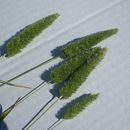Comments
provided by eFloras
A widespread and variable species, often occuring as a garden weed, but where it grows in quantity it has been recommended for fodder. Specimen Sultanul Abedin 3012 (K) from Jilogis is remarkable for having proliferating spikelets in the lower part of some of the panicles. 300-2000 m.
- license
- cc-by-nc-sa-3.0
- copyright
- Missouri Botanical Garden, 4344 Shaw Boulevard, St. Louis, MO, 63110 USA
Description
provided by eFloras
Tufted annual; culms 5-60 cm high, erect or geniculately ascending. Leaf-blades up to 18 cm long and 8 mm wide, flat, vinous to pubescent or ± glabrous. Panicle cylindrical and dense or pyramidal, lax and ± lobed, 1-12 cm long. Spikelets 3-6(-10)-flowered, 3-7.5 mm long; rhachilla not produced, subglabrous or with hairs not more than 0.5 mm long; glumes glabrous or hairy, acute, the lower narrowly lanceolate, 2-3 mm long, 1-nerved, the upper elliptic, 2.5-3.5 mm long, 3-nerved; lemma elliptic, 25-35 mm long, glabrous or sparsely hairy, the surface smooth or minutely papillose, acute; awn 1-3 mm long, usually straight.
- license
- cc-by-nc-sa-3.0
- copyright
- Missouri Botanical Garden, 4344 Shaw Boulevard, St. Louis, MO, 63110 USA
Distribution
provided by eFloras
Distribution: Pakistan (Baluchistan, Punjab, N.W.F.P. & Kashmir); Northwest India to the Mediterranean region; introduced in South Africa, North America etc.
- license
- cc-by-nc-sa-3.0
- copyright
- Missouri Botanical Garden, 4344 Shaw Boulevard, St. Louis, MO, 63110 USA
Comprehensive Description
provided by North American Flora
Koeleria phleoides (Vill.) Pers. Syn. PI. 1 : 97. 1S05
Fesliua phleoides Vill. Fl. Delph. 7. 1785.
Koeleria brachyslachya DC. Cat. PI. Hort. Monsp. 120. 1813. (Type from Europe.)
Lophochloa phleoides Reichenb. Fl. Germ. Exc. 42. 1830. (Based on Fesluca phleoides Vill.)
Annual; culms erect or spreading, often branching at the base, glabrous, several-noded, 15-30 cm. tall; sheaths, especially the lower, somewhat pilose; ligule truncate, erose-dentate, pilose, 1-3 mm. long; blades flat, somewhat rounded or cordate at the base, pilose on the upper surface and sometimes also beneath; panicle pale, dense, spikelike, oblong or ovoid, obtuse, often somewhat narrowed above, 2-7 cm. long, the larger often lobed, the axis and very short branches glabrous, roughish; spikelets 2-4 mm. long, 4-5-flowered; glumes acute, rather broad, glabrous or pilose; lemmas short-awned from a bifid apex, roughened or pilose.
Type locality: Europe.
Distribution: Introduced from Europe at Pensacola, Florida; Mobile, Alabama; Portland, Oregon; and at several points in California.
- bibliographic citation
- Albert Spear Hitchcock, Jason Richard Swallen, Agnes Chase. 1939. (POALES); POACEAE (pars). North American flora. vol 17(8). New York Botanical Garden, New York, NY
Physical Description
provided by USDA PLANTS text
Perennials, Terrestrial, not aquatic, Stems nodes swollen or brittle, Stems erect or ascending, Stems geniculate, decumbent, or lax, sometimes rooting at nodes, Stems solitary, Stems caespitose, tufted, or clustered, Stems terete, round in cross section, or polygonal, Stem internodes hollow, Stems with inflorescence less than 1 m tall, Stems, culms, or scapes exceeding basal leaves, Leaves mostly basal, below middle of stem, Leaves conspicuously 2-ranked, distichous, Leaves sheathing at base, Leaf sheath mostly open, or loose, Leaf sheath smooth, glabrous, Leaf sheath and blade differentiated, Leaf blades linear, Leaf blades very narrow or filiform, less than 2 mm wide, Leaf blades 2-10 mm wide, Leaf blades mostly flat, Leaf blades mostly glabrous, Leaf blades more or less hairy, Ligule present, Ligule an unfringed eciliate membrane, Inflorescence terminal, Inflorescence simple spikes, Inflorescence a dense slender spike-like panicle or raceme, branches contracted, Inflorescence solitary, with 1 spike, fascicle, glomerule, head, or cluster per stem or culm, Inflorescence spike linear or cylindric, several times longer than wide, Inflorescence single raceme, fascicle or spike, Flowers bisexual, Spikelets pedicellate, Spikelets laterally compressed, Spikelet less than 3 mm wide, Spikelets with 3-7 florets, Spikelets solitary at rachis nodes, Spikelets all alike and fertille, Spikelets bisexual, Spikelets disarticulating above the glumes, glumes persistent, Rachilla or pedicel hairy, Gl umes present, empty bracts, Glumes 2 clearly present, Glumes equal or subequal, Glumes distinctly unequal, Glumes 1 nerved, Glumes 3 nerved, Lemma similar in texture to glumes, Lemma 5-7 nerved, Lemma glabrous, Lemma body or surface hairy, Lemma rugose, with cross wrinkles, or roughened, Lemma apex truncate, rounded, or obtuse, Lemma mucronate, very shortly beaked or awned, less than 1-2 mm, Lemma distinctly awned, more than 2-3 mm, Lemma with 1 awn, Lemma awn less than 1 cm long, Lemma awned from tip, Lemma margins thin, lying flat, Lemma straight, Palea present, well developed, Palea membranous, hyaline, Palea about equal to lemma, Stamens 3, Styles 2-fid, deeply 2-branched, Stigmas 2, Fruit - caryopsis.
Rostraria cristata: Brief Summary
provided by wikipedia EN
Rostraria cristata, the Mediterranean hairgrass, is an annual grass species which is native to Eurasia and widely naturalised throughout central and eastern Australia.
- license
- cc-by-sa-3.0
- copyright
- Wikipedia authors and editors

